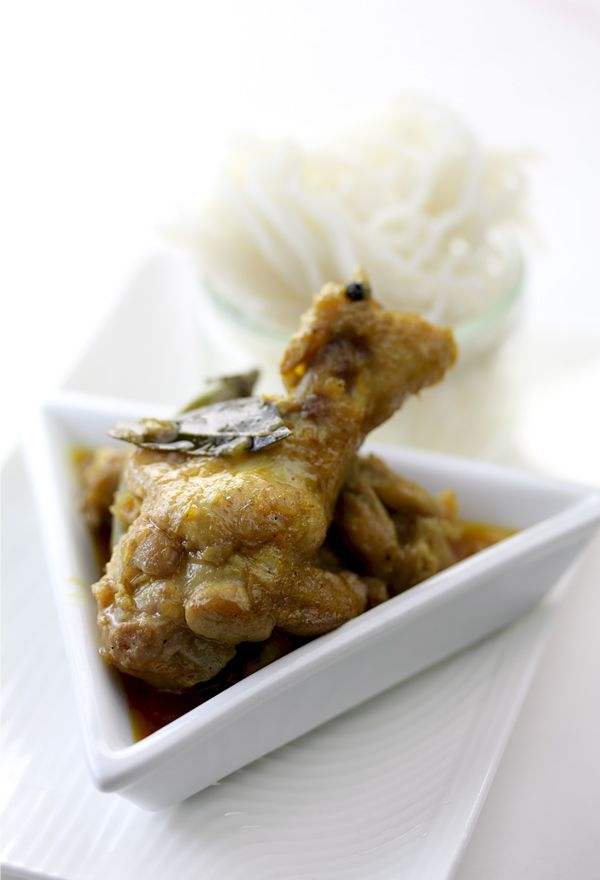Chicken curry is the kind of meal I love when the weather is getting chilly. The subtle heat from the wide range of spices such as cloves, cardamom, green Serrano chiles, curry leaves and nuoc mam is very pleasant, and the gravy is so satisfying when paired with bún (Vietnamese rice vermicelli noodles). The noodles soak up all the delicious flavors from the gravy.
I also love the fact that the dish uses chicken drumsticks because they’re not too big, not too dry and they cook relatively fast. That’s a lot of love in one dish!
1. Info for Bun Cari Ga Recipe (Vietnamese Chicken Curry)
- Cook Time: 1 hr
- Total Time: 1 hr 40 mins
- Servings: 6
- Calories: 609kcal
2. Ingredients for Bun Cari Ga Recipe (Vietnamese Chicken Curry)
- 2 pounds chicken drumsticks
- 1 teaspoon baking powder
- 2 teaspoons salt
- 1 tablespoon green cardamom pods, crushed
- 4 Serrano chiles
- 1 teaspoon whole black peppercorns
- 1½ yellow onions, chopped
- 1 tablespoon grated palm sugar, to taste
- 2 cloves garlic, finely minced
- 1 (2-inch) chunk galangal
- 2 teaspoon fresh curry leaves, torn in half
- 2 tablespoons Thai basil, chopped
- 1½ (1-pound) packages thin round rice noodles (bun), boiled and drained
3. Directions:
3.1 Prepping the chiles
Using a paring knife, create a 2 to 3-inch incision in the peppers. For less heat, remove the seeds (don’t forget to wear disposable gloves).
3.2 Prepping galangal
Clean the root and remove any dirt. Peel the galangal with a paring knife (or the edge of a spoon). Grate about 2 tablespoons of galangal with a fine mesh Microplane. Thinly slice the rest.
3.3 Preparing the chicken
Wash and pat dry the chicken using paper towels. Season with salt, ground coriander, 1 teaspoon of cayenne pepper and black pepper. Add 1 teaspoon chopped garlic and baking powder. Toss well. Place the chicken in a large bowl or a sealable zip-top bag. Drizzle with about 1 tablespoon of oil. Marinate in the refrigerator for at least 2 hours.
3.4 Prepping the cashew nuts
Blanch the cashews and coarsely chop them.
3.5 Assembly time
In a wok, heat the oil. Add the onion and cook on heat high until slightly golden. Lower the heat to medium-low and continue cooking until soft and tender, about 6 minutes. Transfer the mixture to a a food processor and blend until smooth. Set aside.
In the same wok, add the garlic and galangal. Cook until slightly golden. Add the curry leaves, cardamom, Serrano chiles, cloves, turmeric powder, the grated galangal and whole peppercorns. Add the chicken and sear the meat on all sides. Add the onion mixture and water chestnuts and stir until the gravy become thick (about 30 seconds). Add palm sugar, Thai basil and 2 scant cups of water. Bring to a boil, then lower the heat to medium-low. Scrape the caramelized bits from the bottom of the wok using a wooden spoon. Reduce the liquid by cooking for about 10 minutes (uncovered). Add the coarsely chopped cashews. Adjust seasoning of the gravy (if necessary) with salt and pepper. Bring to a boil one last time and cook until the gravy is thickened and the liquid evaporates. Turn off the heat. Cover and let sit until you’re ready to serve.
Serve the curry with bún on the side.
Bon appétit!
4. Tips and advices:
- The result should be “fall-off-the-bone”, tender chicken.
- Chicken is called “gà” in Vietnamese.
- If you can’t find galangal (it can be found in most Asian markets), use double the amount of ginger. Galangal is whiter in color than ginger but it’s much more fragrant.
- Serrano chile adds a nice aroma to the gravy. A small incision shouldn’t bring spiciness to the dish, unless you bite in it of course!
- I used water chestnuts for a crisp, crunchy contrast with the thick curry sauce. You can find fresh water chestnuts or the canned version in most Asian stores.
- Thai basil tastes very different from sweet basil. It imparts a strong, earthy fragrance to the dish.
- For the rice vermicelli noodles, just boil the noodles as you would regular pasta. Drain thoroughly. Let cool completely.
- All the ingredients listed above can be found in any Asian stores.

